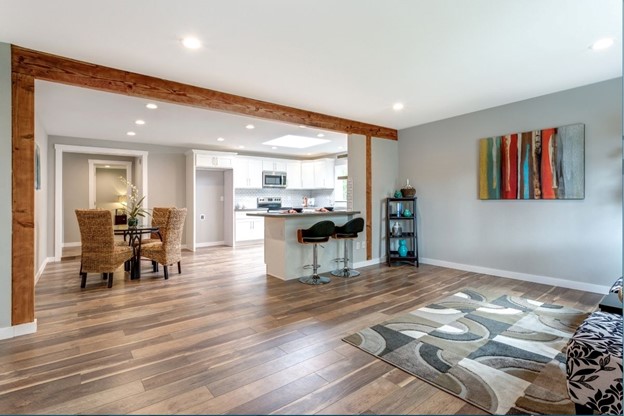
When it comes to designing a home, flooring is not just an aesthetic choice; it's a practical decision that can greatly impact the comfort and functionality of each room. Choosing the right flooring for each area of your home requires careful consideration of factors like durability, style, and functionality. In this guide, we'll delve into the art of selecting flooring that aligns seamlessly with the needs of various spaces, enhancing both their visual appeal and livability.
1. The Inviting Foyer: Making a Grand Entrance
The foyer sets the tone for your entire home, welcoming guests with a first impression that speaks volumes. To withstand the foot traffic and outdoor elements, opt for durable flooring like ceramic tiles or stone. These materials are not only sturdy but also offer a timeless charm that complements various design styles. A patterned or mosaic tile layout can infuse the space with character, while neutral colors provide a versatile canvas for décor.

2. The Heart of the Home: The Kitchen
Kitchens demand flooring that can handle spills, heat, and constant movement. Porcelain or ceramic tiles are practical choices, as they are resistant to stains and easy to clean. Alternatively, luxury vinyl planks can mimic the appearance of hardwood while offering water resistance, making them a sensible compromise between aesthetics and functionality. Consider warmer tones to create a welcoming ambiance, and ensure the flooring seamlessly transitions into adjacent areas.
[caption id="attachment_59101" align="alignnone" width="1920"] Choosing the Right Flooring for Each Room Kitchen[/caption]
Choosing the Right Flooring for Each Room Kitchen[/caption]
3. The Tranquil Retreat: The Bedroom
When it comes to the bedroom, comfort and coziness take center stage. Softness underfoot can be achieved with carpet or area rugs that provide warmth and comfort during morning routines. However, if you prefer a cleaner and more allergen-free option, hardwood or laminate flooring with a plush rug can offer a blend of style and comfort. Opt for colors that promote relaxation and complement your bedroom décor.

4. The Stylish Living Room: Balancing Aesthetics and Durability
The living room is a hub of activity, where style meets daily life. Hardwood flooring is a popular choice, offering both elegance and resilience. If you're concerned about wear and tear, consider engineered hardwood, which is more resistant to moisture and temperature fluctuations. For those who desire the comfort of carpeting, explore options with stain-resistant technology that can withstand spills and heavy foot traffic without compromising style.
5. The Busy Bathroom: Prioritizing Water Resistance
Bathrooms demand flooring that can withstand moisture and humidity without sacrificing style. Ceramic or porcelain tiles are excellent choices due to their water resistance and ease of maintenance. Larger tiles with minimal grout lines offer a sleek and clean appearance. For a touch of luxury, consider heated floors that bring comfort during colder months, transforming the bathroom into a spa-like retreat.

6. The Functional Home Office: Balancing Work and Comfort
In a home office, comfort and functionality intersect. Hardwood or laminate flooring provides a professional look and ease of maintenance. Area rugs can delineate the workspace and add an extra layer of comfort. If you're seeking a quiet atmosphere, consider cork flooring, which has natural sound-absorbing properties. Tailor the flooring choice to your work habits and preferences, ensuring that the space fosters productivity and relaxation.
7. The Versatile Basement: Overcoming Challenges
Basements often present unique challenges due to potential moisture issues. To combat this, consider vinyl or luxury vinyl plank flooring, which is moisture-resistant and offers a wide range of styles. If you prefer a warm and cozy atmosphere, carpet tiles can be a practical solution, allowing easy replacement of damaged tiles. Ensure proper moisture barriers and subfloor preparation to create a comfortable and functional basement space.
8. The Outdoor Oasis: Extending Your Living Space
Outdoor living spaces require flooring that can withstand the elements while complementing your landscaping. Porcelain or ceramic tiles that mimic natural stone are popular choices, offering durability and a seamless transition from indoor to outdoor areas. Consider slip-resistant options to ensure safety during wet conditions. Outdoor rugs can also enhance comfort and style while defining different zones in your outdoor oasis.

Conclusion: Flooring as a Lifestyle Enhancement
Selecting the right flooring for each room involves more than just following design trends; it's about enhancing your daily life. By considering factors such as durability, style, and functionality, you can create a home that not only reflects your aesthetic preferences but also accommodates your practical needs. As you navigate the flooring options for each space, remember that the right choice can significantly contribute to the overall comfort, beauty, and functionality of your home.



















